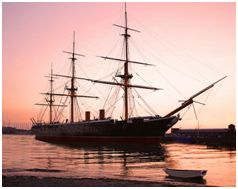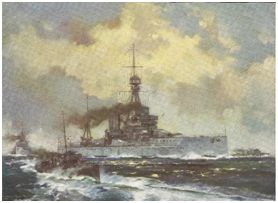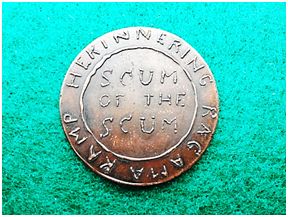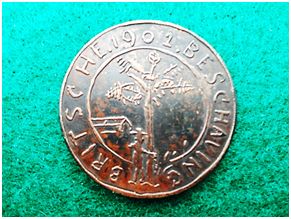


Newsletter No. 515
March 2019
MEMBER NEWS
1.0 Committee member, Major General Chris le Roux and his dear wife, are emigrating to the Land Down Under during March.
On the Branch Members behalf the committee wishes Marlyna and Chris all the best in their new endeavour in Oz.
Tot-siens Generaal, en alles van die beste.
2.0 Long Time Member, Dr Ingrid Machin has been admitted to the Frail Care Centre in her village in Howick and on behalf of the Committee and Members we wish her well for the future.
3.0 The programme for MARCH is Below.
14th March
DDH Search for the Kitty Hawk Crash site Umkomaas - update Donald Davies
MAIN "The Key to Jerusalem" The SA Field Artillery Brigade in Palestine 1917-18. Clive Wilsworth
4.0 THE KEN GILLINGS MEMORIAL TOUR - 2019
Preparations are well in hand for the 2019 KGM Tour which will take to some of the military sites in and around Durban over the week-end of 4th / 5th May 2019.
Please contact Roy Bowman for further information or if you would like to put your name down for this tour.
The Chairman, Charles Whiteing, opened the meeting and apologised for the sudden change of venue to the NMR H.Q., which had been brought about by the unrest at the University of KZN, our normal venue, He then went over the notices for the meeting before inviting Roy Bowman to give a short talk on the proposed Ken Gillings Memorial Tour in May taking in some of the WW2 installations of Durban.
Charles commented on how blessed we were to have two well read Professors to deliver the nights talks before inviting the first speaker for the evening, Professor Philip Everett to present the DDH.
Sail to Steam, Wood to Steel, Broadsides to Turrets
Fellow member Phil Everitt presented the DDH, “Sail to Steam, Wood to Steel, Broadsides to Turrets” and described the development of ironclads in the Royal Navy from HMS Victory to HMS Dreadnought. Most of this development took place in the latter half of the nineteenth century. Having been first drawn to researching the topic by a series of line drawings in the 1947-8 edition of ‘Jane’s Fighting Ships’, his interest was especially drawn to the many different solutions proposed to transition from broadsides to the modern gun turret and the layouts of armour used in the hull.
With extensive use of PowerPoint illustrations, we were taken through the introduction of steam, the transition from paddle wheels to screw propulsion through the contest between the Rattler (screw) and the Alecto (paddle. This was also due in part, interestingly, to the perceived need for more broadside space for guns which led ultimately to the first real ironclad broadside ship, HMS Warrior, as a response to the French Gloire. However, the broadside rapidly gave way to the central armoured battery and then the turret, influenced by the shallow draft USS Monitor. The first deck mounted turrets were extremely heavy and caused stability problems, which was not solved by the turret proponent Cole, whose HMS Captain with turrets mounted on a very low deck, sank when she took seas in a gale.

MHS Warrior
Some of these problems were overcome by the introduction of the introduction of the armoured deck at the waterline, well below the main deck; and finally overcome by the development of the heavily armoured barbette stretching upwards from the low level magazine to open guns often on a ‘disappearing carriage’.
Another interesting development was the reintroduction of the ram as weapon, not used since the days of the Mediterranean oared galley as steam made attack in any direction and rapid withdrawal after ramming possible. However, the accidental ramming and sinking of HMS Victoria by HMS Camperdown along with other accidents caused some second thoughts about the use of the ram.
At the same time the RN was grappling with the idea of breech loading to replace muzzle loading. The initial resistance was finally overcome when an accidental double loading of the ML on HMS Thunderer caused a serious explosion and BL became entrenched.
The final step in gun mounting development, was the initial light covering of the guns in the barbette becoming much thicker armouring and the final development of the modern ‘turret’ which is actually a combination of the barbette and turret.
Introduction of centralised fire control and the enthusiasm of Admiral ‘Jackie’ Fisher then led to the launching of HMS Dreadnought in 1906, the first ‘all big gun’ battleship in 1906. Although other nations were toying with the idea this instantly rendered all ‘pre-Dreadnoughts’ obsolete and set the standard for the final fifty years of battleships worldwide.

MHS Dreadnought
The dramatic unauthorised demonstration of the uncatchable Turbinia by her turbine inventor Algernon Parsons at Queen Victoria’s Diamond Jubilee in 1897 also led to the steam turbine replacing the expansion engines in the Dreadnought class.
Question time was very interesting as members of the audience asked probing questions.
After a short break, where the Natal Mounted Rifles Officers Mess was well patronised, the Chairman introduced the speaker for the Main Talk Professor Donal McCracken whose subject was:
The Scum of the Scum
The main talk of the evening was given by our old Irish friend the inimitable Professor Donal McCracken, with the title “The Scum of the Scum”.
With his unique brand of humorous story-telling, Donal described the disposition of Irish POWs during the Anglo-Boer (South African) War. Being a nation which had for many years been a backbone of the British Army while at the same time harbouring a section of the population just as warlike but with vehemently anti-British sentiments the Irish were found on both sides during the war. Many of these combatants were drawn from the lowest levels of Irish society but others such as Lord Roberts, were to be found in the highest levels of the British Officer class and even on the Boer side a number were well educated.
On the British side a total of some three cavalry and fourteen infantry regiments were deployed to South Africa for the war. Of course a great many Irish were also to be found in English and Scottish Regiments but data in this respect is difficult to isolate.
Of the Irish Regiments out of total casualties of around 4,800 there were nearly 1,900 POWs. In the nature of war however, the majority of these came from the 1st Bn Royal Irish Fusiliers, 2nd Bn Royal Irish Rifles, and the 1st Bn Imperial Yeomanry. This was not an indication of cowardice but rather of poor and inadequate training for the conditions they were to face and their poor deployment; although one battalion was relegated to service functions in the Cape. In general, these POWs were well treated although in at least one case they were forced into a very long march to their eventual camp.
The Irish POWs on the Boer side suffered the same fate regarding destinations as their Afrikaner compatriots. The main destinations settled on by the British after consideration of a long list of possibilities were, Ceylon (47 Irish), St Helena (6), India and Bermuda (5 each) and a final 13 either in SA or unknown.
There was debate in British circles as to whether the Irish should be considered British as Ireland was still an integral part of the United Kingdom, (and possibly even traitors?), or foreign, with much of this argument revolving around whether they were citizens of the ZAR or the US at the time of outbreak of war. This led to some segregation.
Of the majority sent to Ceylon they were housed in a special camp “Diyatawala”, which housed many of the roughest of the rough. However, these men developed a camaraderie and pride in their position and even made and issued their own “Scum of the Scum” medals out of scrap.
This of course was the origin for the title of the talk.


The Professor mentioned that these medals occasionally came up for auction and he had tried once to buy one; but gave up bidding as the price rose towards the eventual knockdown of R20,000 ! He requested that if anyone knew where he could obtain one at a reasonable price to let him know!!
After the war, repatriation came much more easily to the British POWs than the Irish who were thousands of miles from home and where there was the additional complication of the destruction of their farms and homesteads together with the internment and deaths of family in the concentration camps.
Professor McCracken fielded all the questions and comments with great aplomb.
After the customary Vote of Thanks which was given by Dr. John Cooke, Charles closed the meeting with the announcements of the coming talks in March.
South African Military History Society / scribe@samilitaryhistory.org